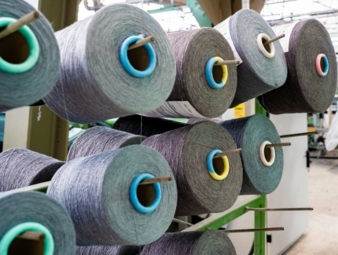22/06/2021 – New life for used textiles made from blended fibers — auf Deutsch lesen
Recycling: From old pants to new seats
Imat-uve is working with a German-Dutch project consortium on an industrial solution for the recycling of old clothes made of mixed fibres.
The engineering and development service provider Imat-uve is developing, together with a consortium of partner companies, a mechanical recycling process that recycles used textiles made of blended fibers for use in vehicle interiors. Previous recycling approaches usually follow chemical processes and therefore cannot be seen as wholly sustainable.
The mountains of old clothes are growing massively and are largely destroyed instead of being recycled and returned to the textile industry. Old textiles are a valuable raw material that can be easily reused. Imat-uve is working with a German-Dutch project consortium on an industrial solution for the recycling of old clothes made of mixed fibres. The recycling yarns and woven fabrics are primarily intended for use in the automotive industry. 1.01 million tons of textiles, old clothes and new garments that have never been worn end up in the trash in Germany alone every year (source: BSVE). So far, there is no possibility to process these quantities of old textiles in a high-quality way. Most of the textiles are burned or processed to low quality nonwovens. The problem is the different components of the clothing, which in most cases are not made of pure but mixed fibers.
Mechanical recycling process without chemicals
By optimizing the recycling process, the blended fibers can be torn very finely and processed into a particularly soft, uniform card sliver by new spinning preparation technologies. This forms the best basis for spinning. The resulting high-quality yarns (Nm15 and Nm28) can be further processed for different requirements, depending on the blending of polyester. In the trials of the project, 12 yarn qualities in different mixing ratios have been spun in the meantime. All approaches to spinning, both in the pilot plant and on industrial spinning machines, led to very good results. The raw material for the production of the yarns consists of sorted used workwear (made of 60 percent polyester and 40 percent cotton) and old clothes (made of unknown fiber blends) as well as raw polyester.
Fabrics for highest demands
From the resulting recycling yarns, Imat-uve created various fabric samples. The weaving process shows an excellent result. Even yarn made of 100 percent mixed fibers could be woven industrially without complications. There were no thread breaks and hardly any fiber abrasion during weaving. In tests with previous yarn and weaving versions, standard tests for the automotive industry, where high demands are placed on the durability and comfort of the textiles, have already been passed very well. For example, the Martindale test was used to certify a resilience of at least 50,000 tours in terms of abrasion behavior. The modified Martindale tests for internal and external pilling and hot-light aging also produced good results.
The prognosis for the current fabrics suggests even more promising test results in the next test series. The project partners are eagerly awaiting further weaving trials in late summer 2020, in which yarns made of 100 percent blended fibers are processed not only as weft but also as warp threads. A yarn spun with open-end technology in a gauge of Nm28/2 will be used as a warpable variant in the next series of tests.
Mixed fiber recycling is also of interest for sophisticated designs. The natural mixing of materials and colors in the raw material results in attractive colorations of the yarn and fabric.
Special color compositions are also possible through targeted pre-sorting of the old clothes.
Push for the textile industry in the border region Germany / Netherlands
Besides Imat-uve, the project consortium consists of the partners C2C ExpoLab, FBBasic, Stichting Texperium and Trützschler. The project is supported by the European Union within the framework of the INTERREG Germany-Netherlands program and co-financed by the North Rhine-Westphalian Ministry of Economic Affairs (MWIDE NRW), the Dutch Ministry of Economic Affairs and Climate (EZK) and the provinces of Limburg and Overijssel.
The requirements of the automotive industry are regarded as the highest goals of the application, but the developed yarns are also to be made available to other sectors such as architecture, home textiles and clothing. In the sense of a circular economy with Cradle to Cradle (C2C) principles, the joint project aims to reduce the CO2 footprint of textiles and strengthen the textile industry in the Rhine-Meuse region. The process and product innovation is to be used to establish the textile industry in the border region between Germany and the Netherlands as an innovation leader in the field of mixed fiber recycling and textile recycling management.





